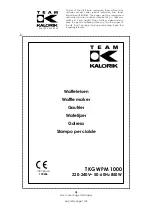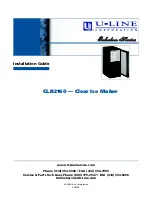
25
Fig. 6.1: Cut-away view of the ice-making system
During pauses in operation which last more than 2-3 days, the ice cube maker should be taken out of operation
as a matter of course.
CAUTION: power voltage is still connected!
This allows you to save electricity and
water. In addition, the residual water from the last ice cube preparation process should be completely emptied
out of the trough. This is strongly recommended for reasons of hygienic during periods when the equipment is
not in operation.
When cleaning the ice cube maker (in particular the trough and the water level sensor), this switch position
should also be selected. This makes access to the trough easier and enables faster and more effective cleaning
(see Cleaning Instruction, chapter 7.1.1).
CAUTION:
For hygienic reasons, the ice cubes from the first two production cycles are not suitable for
consumption. Please remove them from the storage container.
6. Operation
6.1 Operating principle
At the start of the ice-making process, the trough is filled with water via the fresh water supply tube. An
electronic water level control device ensures that only the actually required amount of water is supplied.
Once the trough is filled, it is set in motion by the trough motor. This generates a controlled wave movement of
the water.
The evaporator is located above the trough, with 'evaporator fingers' reaching into the trough. The water freezes
on the 'evaporator fingers' that are cooled by the refrigerant, causing ice cubes to form.
The wave movement causes only water molecules to
adhere to the 'evaporator fingers', while minerals (e.g.
lime) and contaminants remain in the water residue.
This ensures that the ice cubes are clear, even at higher
degree water of hardness.
The ice thickness motor continuously measures the ice
thickness. Once the
factory-set
ice cube size is
reached, the ice-making process is terminated (please
see chapter 6.2. regarding the size of the ice cubes).
CAUTION: Please pay attention to the safety
measures in chapter 2.2!
The unused water is fed into the drain via a separate
channel by tilting the trough. This ensures that contact
with the ice cubes already produced is avoided, so that
the cubes remain hygienically clean.
The automatically initiated defrosting phase causes the
ice cubes to be separated from the evaporator, so that
they fall into the storage container. Once all ice cubes
have been separated, the trough returns to its original position below the 'evaporator fingers'.
A new ice-making process commences. This procedure is repeated until the storage container is full.
Once the storage container is full, the device switches off automatically. It automatically switches back on again
once a sufficient number of ice cubes has been removed from the storage container.
The storage container is illuminated by blue LED’s when the machine is operational (production switch to the
left).
NOTE:
In case of longer production breaks (e.g. Holidays), it is recommended that you switch off the machine
(production switch to the right) for hygienic reasons (automatic emptying of residual humidity of the production
trough) and for cost saving reasons (water and electricity).
E
N
G
L
I
S
C
H
E
N
G
L
I
S
H
A
N
G
L
A
I
S
















































